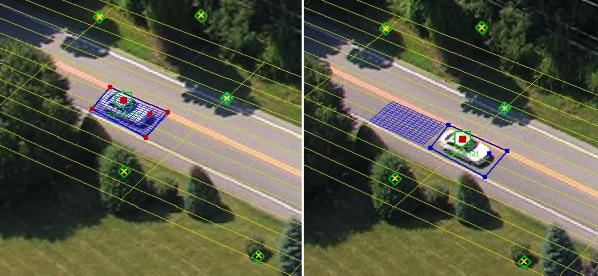< Previous | Contents | Manuals Home | Boris FX | Next >
Disjoint Overlap Modes
Now that you've seen how to control which pixels are shifted, with splines and removal meshes, you're ready to consider the Disjoint timing modes.
When you are removing something from a single shot, you must find replacement pixels from a different frame that don't themselves contain the thing being removed. The more frames there are between the frame being worked on and the source frame containing replacement pixels, the more the replacement is likely to be a visual mismatch, ie contain differences in brightness, color, perspective, illumination direction, etc. It's desirable to be able to find the replacement as few frames away as possible, but of course far enough to not contain the thing being removed.
Note : Disjoint mode isn't relevant to tripod shots, because there's no way to see behind an occluding object if the camera doesn't move. Use one of the fixed timing modes, or Same Direction.
The disjoint overlap modes, Disjoint leading and Disjoint trailing, automate the process of finding the closest frame from which replacement pixels can be pulled.
Operation is fundamentally simple: starting from the frame we want to replace on, scan forwards or backwards until the area being replaced, as seen from the source camera on the source frame, doesn't overlap the area containing the bad thing, again on the source frame. An illustration will help:

In the image on the left, we have a spline surrounding the car being removed.
Matching the spline, we've put an extra little blue mesh onto the road plane to serve as a stationary reference for where the car is on this frame (frame 20), which is the region of frame 20 that we want to replace. Scrubbing forward through the shot, the blue mesh matching frame 20 stays put in 3D, while the car and its spline move forward. If we looked at frame 26, say, the car and spline would still be sitting partially on the blue mesh. But by the frame above on the right, frame 34, the car has moved completely off the blue mesh. Victory! We can use 34 as the source frame, pulling the pixels under the blue mesh back into frame 20 to remove the car. The Disjoint modes repeat this analysis for each viewing frame.
The difference between Disjoint leading and Disjoint following is the direction in which ViewShift looks for a non-overlapping frame. In Disjoing leading mode, ViewShift scans to larger frame numbers: the source camera leads the viewing camera. In Disjoint following mode, ViewShift scans backward to earlier frames: the source camera follows the viewing camera.
At the beginning or end of the shot, there typically won't be any additional frames in the desired direction to pull from. If ViewShift can't find a source frame in the intended direction, it will try in the other direction instead.
If you have multiple regions being removed, they are considered as a group. For example, if you're removing three cars, it looks for a frame where all three cars can be completely removed without bringing in part of any part of the three cars.
ViewShift will also make sure that it doesn't shift any pixels that are part of a garbage spline on the source shot. (See the note at the end of Controlling ViewShift with Splines for how to have separate source and viewing splines even for the same shot.)
Note : Disjoint modes aren't generally useful with different source and viewing shots, as there's no issue with overlap between the source and target pixels. You might use the mode if you want the source frame to avoid some animated source garbage splines. But that seems unlikely.
After a shot is run using a Disjoint overlap mode, the utilized frame numbers are written to the Frame control track. You can examine those values to check the operation, and if necessary, edit them then switch to Absolute mode.
Note that ViewShift doesn't consider or indicate whether areas being shifted extend off the edge of the source image, which results in the desired removal being incomplete. If that happens, in many cases it is unavoidable, so we leave it up to you to address that if it is possible, by adjusting the Frame control track or perhaps by adding source garbage splines at the edge of the image.
Reminder : if you use Disjoint mode, the timing of the source shot will not be constant, and may contain speed-ups, slow-downs, jumps, or drops, depending on the camera motions.
©2024 Boris FX, Inc. — UNOFFICIAL — Converted from original PDF.
